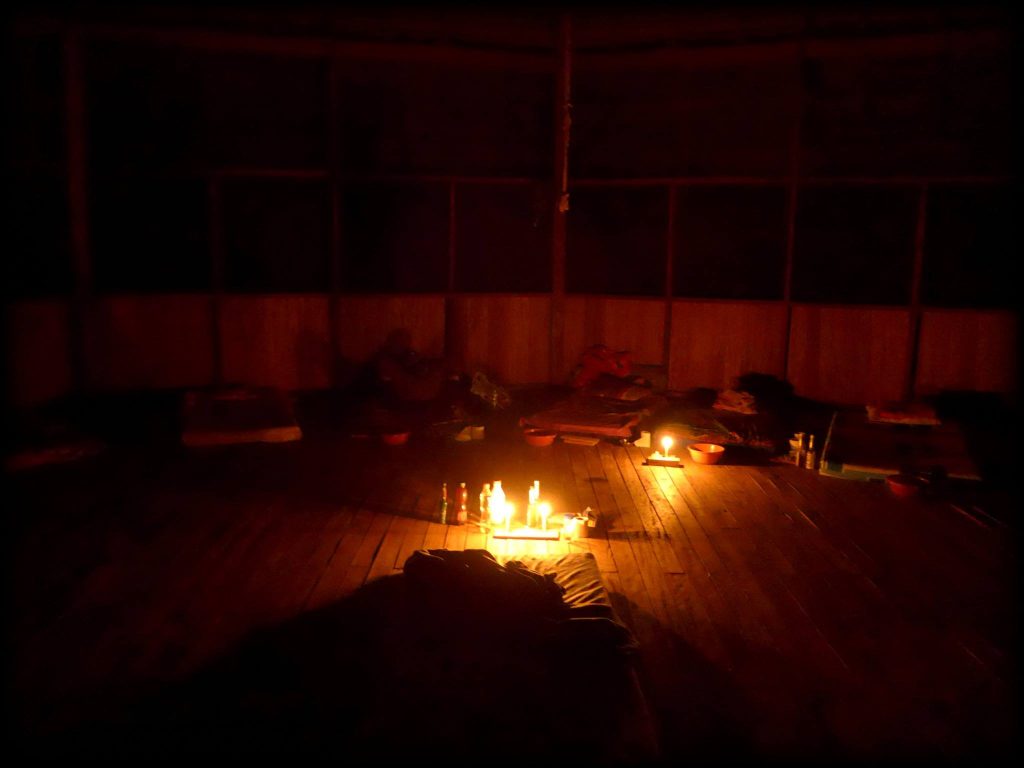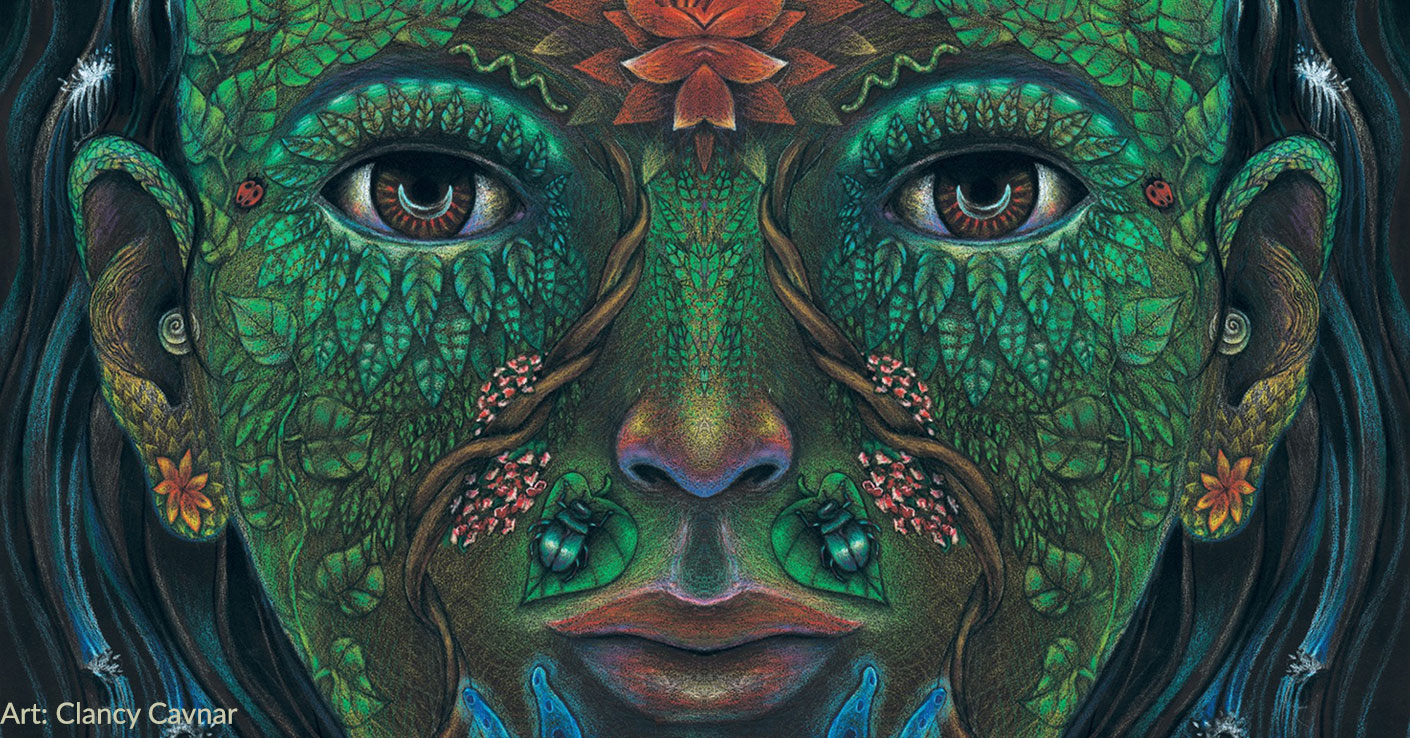- Are Psychedelic Hallucinations Actually Metaphorical Perceptions? - April 19, 2017
Psychiatrists usually define hallucination as a sensory experience that appears to be real, but is not produced by any actual object of the environment.1 Key, in this definition, is the claim that hallucinations unfold independently of the real world: when one is hallucinating, one is making up objects that are not really there.
Can this definition of hallucination be appropriately applied to psychedelic “hallucinations”? On the one hand, many psychonauts aver that psychedelic visions are caused by entities existing in some parallel reality, and are therefore as real as everyday objects.2 On the other hand, many naturalistically inclined psychiatrists and neuroscientists contend that these hallucinations are purely phantasmagorical. My ethnographic work among the Shipibo shamans of the Ucayali River in Peru, my first-hand experience of ayahuasca, and the examination of up-to-date neuroscientific models of the brain led me to think of ayahuasca visions differently. They are not hallucinations but metaphorical perceptions: They result from the perception of actual environmental stimulation recombined in unique and unusual ways.
How the Brain works: Perception as Prediction
Recent neuroscientific models of the brain stress the importance of prediction within perceptual experience.3 The tenets of the predictive model of the brain can be described with a useful analogy: that of helmsmen steering collective boats on the rivers of lowland South America.
In the Amazon, to go from one riparian town to another, people usually take a collective boat. Most boats carry between 20 to 60 passengers. These boats are steered in an intriguing way. The helmsman is positioned at the rear part of the boat. Because of this, he cannot see much of the river; what he sees in front of him are mostly the backs of passengers. Yet, the helmsman critically needs to know in minute detail where he is going, as the river is replete with shallows and floating tree trunks that must be avoided by any means. The usual way to make sure that the helmsman is able to steer the boat safely is to position a lookout at the front part of the boat and to have him warn the helmsman in case anything dangerous shows up ahead.
The human perceptual system roughly works like these collective boats! “Predictive models” of perception strongly contrast with “constructive models,” developed in the 1970s. According to constructive models of visual perception, the retina collects very gross and sparse information about the world, and each level of the visual system elaborates on this limited primary information and makes it gradually richer and more complex.4
Let us say that the lookout stands for primary perceptual areas—low-level areas of the brain—and the helmsman stands for more frontal areas; the high-level areas of the brain. Furthermore, the trajectory of the boat stands for conscious perception. In the case of classical constructive models of the brain, perception is taken to be a gradual enrichment of information coming from lower areas of the brain. So, to use the boat analogy, constructive models of perception have it that the trajectory of the boat—i.e., conscious perception—is determined by the lookout sending warning signals to the helmsman—i.e., by bottom-up processes.
Predictive models conceive of perception in a very different way. The first step of determining the trajectory of the boat is the helmsman guessing, on the basis of his past experience, where the boat can safely go. So, within the predictive model, the lookout plays no constitutive role. The lookout influences the trajectory of the boat only when the helmsman’s predictions are proved wrong, and when the lookout needs to warn him.
Two niceties must be added. First, bottom-up error signals can be variously weighted. In noisy or uncertain situations, bottom-up prediction errors have a smaller influence than usual:5 in noisy or uncertain situations, the lookout’s warnings are not taken into account by the helmsman as much as usual. Second, in the boat analogy, there is only one lookout and one helmsman. In the brain, several duos of lookouts and helmsmen are working together, and each of these duos is specialized in a specific perceptual modality.
The (Un)Making of Spirits: Ayahuasca Ritual in Shipibo Shamanism
The predictive model of perception can shed interesting light on Shipibo ayahuasca rituals. These rituals typically take place in a maloca (circular ceremonial building) during the night. Half an hour after the ingestion of the beverage, shamans start to sing magical songs known as icaros. In addition to these songs, the ritual also includes use of perfumes (such as agua florida), tobacco (Nicotiana rustica), and at times, other paraphernalia (such as the leaf-bundle rattle locally known as chacapa).

– Collective boats in Yarinacocha, by Martin Fortier
During my fieldwork, shamans kept repeating that the purpose of the ayahuasca experience was to encounter good spirits and receive healing and teachings from them. These good spirits are bright, luminous, and benevolent, and they contrast with bad spirits whose colors and energies are dark and murky. “When you see a bad spirit in your ayahuasca experience,” they said, “you must spray perfume or blow tobacco on it, and it will immediately disappear.”
The brain is constantly attempting to predict what is going on in the world. Because it happens in a dark environment with reduced sensory stimulation, the ayahuasca ritual dampens bottom-up signaling (sensory information becomes scarcer). If you are facing a tree in daylight and your brain wrongly guesses that there is an electric pole in front you, bottom-up prediction errors will quickly correct the wrong prediction—i.e., the lookout will quickly and successfully warn the helmsman. But if the same happens in the dark, bottom-up prediction errors will be sparser and vaguer, and possibly not sufficient enough to correct errors—as it were, the lookout’s warning will be too faint to reach the helmsman. As ayahuasca introduces noise in the brain processes,6 and because bottom-up corrections cannot be as effective as usual, hallucinations appear more easily. So, on the one hand, the relative sensory deprivation of the environment in which the ayahuasca ritual takes place, and the absence of bodily motion, both favor the occurrence of hallucinations.
 – Ayahuasca ceremony in Ibo Rao, by Martin Fortier
– Ayahuasca ceremony in Ibo Rao, by Martin Fortier
Furthermore, the ayahuasca ritual does include some sensory richness. The songs, the perfume, and the tobacco stimulate the brain in multiple ways. Psychedelic hallucinogens are known to induce synesthesia7 and to increase communication between areas and networks of the brain that do not usually communicate with each other.8 It is hence no surprise that the shamans’ songs are able to shape people’s visions. If one sensory modality is noisier or fainter than others, its role in perception will be downplayed.9 This is what happens with ayahuasca: Given that not much information can be gathered by the visual modality, most of the prediction errors that contribute to the shaping of conscious perception are those coming from the auditory and olfactory modalities. The combination of synesthetic processing with the increased weight attributed to non-visual senses enables shamans to “drive” people’s visions.
The same mechanisms explain the shamans’ recommendation that perfume should be sprayed or tobacco blown when one is faced with a bad spirit. Conscious perception—e.g., vision of a spirit—is the result of a complex tradeoff between top-down predictions and bottom-up prediction errors. If you spray a huge amount of perfume or blow wreaths of smoke around you, your brain will receive new and reliable information from the olfactory modality. Under psychedelics, sensory modalities easily influence one another; as a result, a sudden olfactory change amounts to sending prediction errors to upper regions of the brain. Conscious perception is updated accordingly: as predicted by the shamans’ recommendation, the olfactory change dissolves the vision of bad spirits.
 – Maestro Roberto (Shipibo healer), in Ibo Rao, by Martin Fortier
– Maestro Roberto (Shipibo healer), in Ibo Rao, by Martin Fortier
Conclusion: Ayahuasca Visions as Metaphorical Perceptions
In its classical sense, hallucination refers to sensory content that is not caused by objects of the world. The above description of the ayahuasca ritual demonstrates that psychedelic visions are not, in the classical sense of the term, hallucinations. Indeed, the content of the visions is tightly tied to the environment: A change of melody in a song or an olfactory change can completely transform the content of the visions. Ayahuasca visions are not caused by hypothetical supernatural entities living in a parallel world, nor are they constructed independently of the mundane objects of the world. What are they, then? They are metaphorical perceptions.
In everyday life, melodic and olfactory changes cannot affect vision much. However, because ayahuasca experience is profoundly synesthetic and intermodal, ayahuasca visions are characteristically metaphorical: A change in one sensory modality easily affects another modality. Ayahuasca visions are not hallucinations, since they are caused by real objects and events; for example, a cloud of perfume. It is more accurate to define them as metaphorical perceptions: they are loose intermodal interpretations of things that are really there.
I would like to conclude with a caveat. So far, I have assumed that spirits and things seen while under the effects of ayahuasca are reducible to brain processes. Such a naturalist and reductionist approach will certainly appear as quite disputable to many of the psychonauts who have had the joy of discovering the world of ayahuasca. However, reducing a thing to brain processes does not amount to pulling it down or declaring it uninteresting and worthless. For instance, one may very well acknowledge that love is nothing more than a matter of neurochemical balance in the brain, and yet deem it one of the most wonderful and valuable things in life. So it goes with ayahuasca spirits.
References
- American Psychiatric Association. (1994). Diagnostic and statistical manual of mental disorders, Fourth edition. Washington DC: Author. ↩
- See for example: Strassman, R., Wojtowicz, S., Luna, L. E., & Frecska, E. (2008). Inner paths to outer space. Rochester VT: Park Street Press. ↩
- Friston, K. (2010). The free-energy principle: A unified brain theory? Nature Reviews Neuroscience, 11(2), 127–138; Hohwy, J. (2013). The predictive mind. Oxford, UK: Oxford University Press. ↩
- Marr, D. (1982). Vision. San Francisco: Freeman. ↩
- Clark, A. (2013). The many faces of precision. Frontiers in Psychology, 4, 270. ↩
- Corlett, P., Frith, C., & Fletcher, P. (2009). From drugs to deprivation: A Bayesian framework for understanding models of psychosis. Psychopharmacology, 206(4), 515–530. ↩
- Luke, D., & Terhune, D. (2013). The induction of synaesthesia with chemical agents: A systematic review. Frontiers in Psychology, 4, 753. ↩
- Roseman, L., Leech, R., Feilding, A., Nutt, D., & Carhart-Harris, R. (2014). The effects of psilocybin and MDMA on between-network resting state functional connectivity in healthy volunteers. Frontiers in Human Neuroscience, 8, 204. ↩
- Ernst, M., & Banks, M. (2002). Humans integrate visual and haptic information in a statistically optimal fashion. Nature, 415(6870), 429–433. ↩
Take a minute to browse our stock:
Did you enjoy reading this article?
Please support Chacruna's work by donating to us. We are an independent organization and we offer free education and advocacy for psychedelic plant medicines. We are a team of dedicated volunteers!
Can you help Chacruna advance cultural understanding around these substances?














